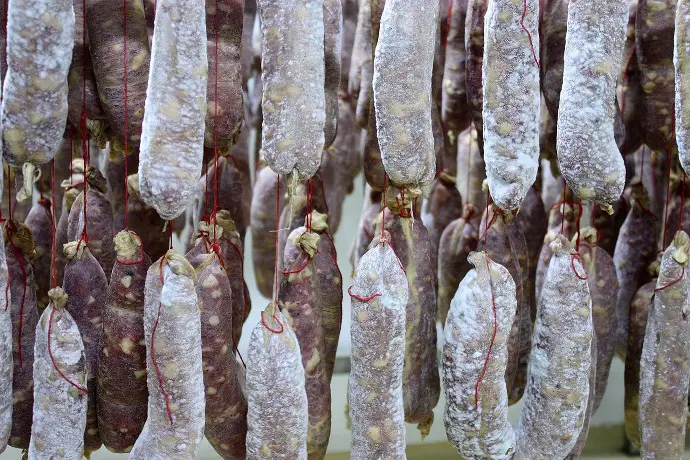If the idea of crafting your own salami has crossed your mind, you’ve likely delved into various methods for producing this savory meat.
But have you ever considered the intriguing prospect of making salami without the use of a starter culture?
This article will guide you through the essential steps of salami-making, from selecting the right meat to curing, grinding, stuffing, fermenting, drying, and storing.
Read on to uncover all the vital details of this unique process.

Table of Contents
Is It Possible to Make Salami Without Starter Culture?
Starter cultures are a blend of either a single strain or a combination of different bacterial strains. When introduced to meat, these cultures unleash a myriad of beneficial effects.
They contribute to the enhancement of color, flavor, and aroma, with a paramount focus on rendering the meat safe for consumption.
Undoubtedly, they bring numerous advantages to the table. However, the burning question emerges: Are starter cultures an absolute necessity for salami production?
Surprisingly, the answer is no. Crafting salami without the aid of a starter culture, such as bactoferm, is entirely possible. This traditional method of meat preparation predates the widespread availability of commercially purchasable starter cultures.
In this scenario, the omission of starter cultures doesn’t mean compromising on quality or safety. Instead, it involves following a set of different steps to ensure that your salami attains peak quality and remains safe for consumption.
> Read more information about Black Spots on Salami by visiting here.
How to Make Delicious Salami Without Using Starter Culture
Embarking on the journey of crafting salami without the assistance of starter cultures involves a unique reliance on the natural bacteria already present in the salami itself.
Let’s explore the step-by-step process:
Pick high-quality Meat

The cornerstone of exceptional salami lies in the careful selection of fresh meat. Opt for cuts that are free from bacterial infection, emphasizing the importance of choosing meat from healthy animals.
Contrary to common belief, the meat of a healthy animal does not inherently contain harmful bacteria.
Handling the meat with precision is of utmost importance. The sooner you process the meat, the better, as this significantly reduces the risk of contamination.
While it’s impossible to entirely eliminate bacteria, the goal is to minimize the risk as much as possible through proper handling and prompt processing.
Curing
During this pivotal stage, the infusion of salt and sugar into the meat is imperative. It is essential to incorporate curing salt, enriched with sodium nitrate, a potent preservative meticulously selected to obliterate deleterious bacteria within the salami, ensuring the meat’s enduring safety.
Curing not only fortifies the flavor, aroma, and hue of the meat but also fosters the cultivation of beneficial bacteria. This meticulous process grants these advantageous microorganisms the necessary time to flourish.
Nonetheless, it is crucial to acknowledge the simultaneous proliferation of harmful bacteria. This underscores the significance of the addition of salt and nitrate, as these microorganisms are not impervious to the inhibitory effects of salt, thereby retarding their growth.
Meat Grinding

While not obligatory, grinding the meat at this juncture facilitates the penetration of the mixture from the preceding step into the meat fibers. This process is integral to achieving a more homogeneous blend of flavors and ensuring optimal infusion.
Crucially, this grinding operation should be conducted at low temperatures, steadfastly maintaining them below 54°F (12°C). This meticulous temperature control is imperative to preserve the integrity of the meat and uphold the desired quality of the final product.
Stuffing
Within this phase, a plethora of choices unfolds, offering the flexibility to opt for either natural or synthetic fibrous casings, each presenting varied diameters to suit your preferences.
In the instance of selecting natural casings, it is imperative to bear in mind that these originate from an animal’s intestinal tract, inherently carrying bacteria.
Despite meticulous cleaning and washing, an abundance of caution is warranted to ensure the casings are rendered 100% safe, preventing any potential contamination of the meat upon contact.
To achieve this, adhere to the following precautionary measures:
- Conduct a thorough visual inspection of the casings, ensuring a pristine white appearance.
- Apply a salting process and store the casings in your refrigerator.
- One hour preceding the stuffing phase, desalt the casings in cold water.
- Employ a 2% vinegar solution to wash the casings thoroughly, thereby guaranteeing cleanliness and safety before they come into contact with the meat.
Fermentation
This pivotal stage involves elevating the temperature of the salami, fostering the growth of bacteria within the meat. Given the absence of a starter culture in this process, adhering to lower temperatures is advisable.
The duration of fermentation is contingent upon the temperature employed. For instance, within the range of 66-76°F (18-24°C), fermentation typically spans 1-2 days. Conversely, if the temperature is maintained at around 50-54°F (10-12°C), the fermentation process extends to approximately a week.
A critical aspect of this step involves the use of a pH meter to monitor the acidity of the salami. This tool is indispensable for determining the conclusion of the fermentation process.
For traditionally prepared salami, the target pH should hover around 5.2, ensuring optimal flavor and safety.
Simultaneously, meticulous attention must be devoted to humidity levels, which should be sustained at approximately 90-95%. This environmental condition is instrumental in fostering the desired fermentation process and ultimately contributes to the distinctive quality of the salami.
Drying

This phase, constituting the most protracted duration of the process, extends over approximately 2-3 months, meticulously maintained within a temperature range of 50-58°F (10-14°C).
The temperature can be elevated, leading to a shortened drying phase. The humidity factor is once again pivotal, ideally fluctuating between 70-85%. Considerably, a gradual reduction to 75% is recommended for optimal outcomes.
In the pursuit of superior results, the intricacies of drying time hinge upon various determinants:
- Casing Size: Larger casings invariably demand a more prolonged drying period.
- Fat Content: The quantity of fat within the meat exerts a direct influence on the drying pace, with higher fat content expediting the process.
- Humidity and Temperature: Lower humidity coupled with elevated temperatures contributes to a swifter drying trajectory.
- Airspeed: Augmented air draft expedites the overall drying process.
Storing
Upon reaching a water activity level of 0.89 or below, your salami attains readiness for storage at cool temperatures. Storing it demands a cold, dark, and well-ventilated environment.
Critical to the preservation of salami quality is the maintenance of humidity at approximately 75%. Exceeding this threshold risks fostering mold growth.
Salami With Vs Without Starter Culture
Choosing a salami-making method involves considering various factors, with the primary distinction revolving around flavor and health considerations.
Flavor:
The pivotal aspect in this regard is taste. Some enthusiasts argue that salami crafted without a starter culture exhibits a more intricate and nuanced flavor profile.
Conversely, those favoring a starter culture often appreciate the consistent flavor it imparts.
Health Benefits:
Salami produced without a starter culture boasts a higher content of live bacteria, contributing to gut health. However, it’s crucial to note that the presence of live bacteria also elevates the risk of food poisoning if not cooked correctly.
On the contrary, salami made with a starter culture contains fewer live bacteria, diminishing the likelihood of food poisoning. While this may reduce the potential health benefits related to live bacteria, it offers a safer consumption option.
Ultimately, the choice between these methods hinges on personal preferences, balancing flavor intricacies and health considerations based on individual priorities and risk tolerances.
Conclusion
You now have the freedom to savor this delectable sausage by incorporating ingredients of your choice.
This not only proves to be a cost-effective endeavor but also grants you the opportunity to experiment with various techniques, ultimately yielding the finest results.
By adhering to our comprehensive step-by-step guide and integrating the provided tips, success is virtually assured. So, feel free to unleash your culinary creativity!
Made without starter
Lactic acid, ground meat, ever thought about making, meat and fat, home made, dextrose, ever considered making.

Fernando is the creator and writer behind the food blog Eating with your Hands. Living and working in cities like Paris, Barcelona, and Berlin, and being married to a Canadian foodie, has given Fernando a passion and interest in food and inspired him to run EWYH.
